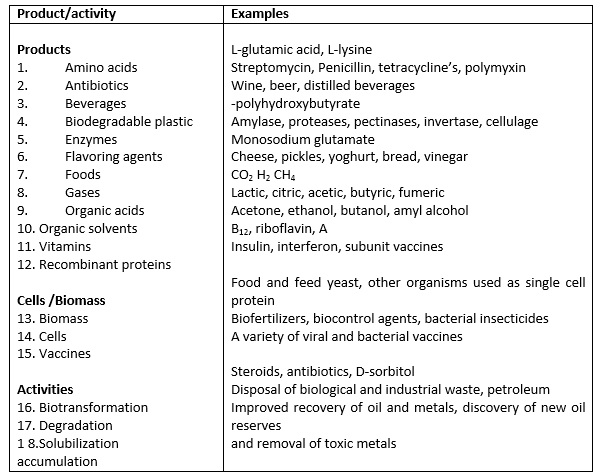MicroBiology Assignment Help
Introduction Of Microbiology
The use of microbes to obtain a product, which increase the economic value, constitutes industrial microbiology. The term industrial microbiology and fermentation are virtually synonymous in their scope, objectives and activities. The microbial product may be microbial cells (living or dead), microbial biomass (usually processed), and components of microbial cells, intracellular or extracellular enzymes or chemicals produced by the microbes utilizing the medium constituents or the provided substrate. The services generated by microorganisms range from the degradation of organic wastes, detoxification of industrial wastes and toxic compounds, to the degradation of petroleum to manage oil spills, etc. The industrial microbiology also encompasses activities like production of bio-control agents, inoculants used as bio-fertilizers, etc. The activities in industrial microbiology begin with the isolation of microorganism from nature, their screening for product formation, improvement of product yields, maintenance of cultures, mass culture using bioreactors and usually end with the recovery of products and their purification. The industrial microbiology is very important which increases the economical values of our country.
Microbiology History
Microbes have been employed for product generation, e.g., wines, bread etc., since thousands of years, but these activities were purely art. The science of industrial microbiology is only about 150 years old. The first observations of microorganisms by Leeuwenhoek were published by the Royal Society, London in 1677, and later in 1684. The experiments of Spallenzani (1799) and those of Schwan (1837) not only disproved the idea of spontaneous generation of microorganisms, but also provided a means of sterilization of liquids (by hest) and air (by heat), respectively. Schwan’s findings also suggested that alcoholic fermentation was due to a fungus or mold, i.e., yeast, and inoculation resulted in quicker fermentation. But microbiology is widely considered to have begun in 1857 when Pasteur reported his studies on lactic acid fermentation, including the microscopic features of the microorganisms are a suitable medium for the process. In 1860, Pasteur reported the first synthetic medium for microorganisms, and used it to study alcohol fermentation. in 1961, Pasteur showed that growth and physiology of yeast differs depending on the presence or absence of O2. This phenomenon is known as Pasteur Effect.
Microbial products/activities of realized/potential importance


In 1878, Lister described the dilution technique for obtaining the first pure microbial culture of lactic acid bacterium. A simpler and more effective technique of obtaining pure cultures from isolated separate colonies developed on solidified medium was described by Robert Koch in 1881; today this technique is widely followed. In 1976, Cohn showed that bacterial spores have a high level of heat resistance and developed the technique of ‘intermittent sterilization’ for their inactivation. Petri plate was devised by Petri in 1887. In 1897, Buchner demonstrated alcohol fermentation by cell-free yeast juice: he suggested that a proteinaceous enzyme was responsible for fermentation. Wildiers demonstrated in 1901 that yeast required growth factors (vitamins) for growth, especially at low inoculums levels; vitamins are used in fermentation even today. In 1917, d’ Herelle described the biological properties of the parasite of dysentery bacillus, and called it bacteriophage; phages are important since they pose a constant threat to bacteria and actinomycetes used for fermentation.
In 1929, Alexander Fleming accidentally discovered penicillin produced by Penicillium growing as contaminant in a Petri plate of Staphylococcus. Fleming developed the technique for assay of antibacterial activity of penicillin using bacteria and showed its low toxicity to man and animals. Many types of other antibiotics are also discovered during Second World War, like streptomycin, chioramphenicol, tetracyclines, etc. The scientific basis of industrial microbiology began with the 1857 paper of Pasteur. Although most of the early work was not aimed to solve problems of industrial microbiology, it did have a strong bearing on the subject and many of the techniques and concepts of early days are valid even today.
Isolation and Screening of Microorganisms:
The success of an industrial fermentation process chiefly depends on the microorganism strain used. An ideal producer or economically important strain should have the following characteristics.
MicroBiology Assignment Help By Online Tutoring and Guided Sessions from AssignmentHelp.Net
- It should be pure and free from phage.
- It should be genetically stable, amenable to genetic modification by mutagenesis.
- It should produce both vegetative cells and spores.
- It should grow vigorously after inoculation in seed stage vessels.
- It should produce a single valuable product, and no toxic by-products.
- The product should be produced in a short time, e.g., 3 days.
- It should be amenable to long term conservation.
- The risk of contamination should be minimal under the optimum performance conditions.


